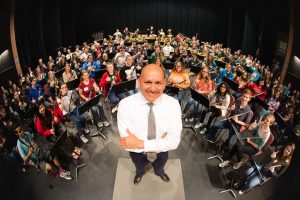 Cornerstone I: Creating and Preparing a Plan
Cornerstone I: Creating and Preparing a Plan
Guess what, I have good news and better news! Throughout the years, a vast body of research has helped to define what success in education should resemble. The good news is that, based on decades of educational research performed by nationally-respected giants, there seems to be cornerstone concepts that most educational researchers agree upon. The better news is that well-respected music educators in the profession faithfully implement similar strategies in their approach to teaching. So, what does the research indicate and how do masters in the profession skillfully implement the cornerstones of successful teaching? What follows is the beginning of a five-article series that shares strategies that can be used TODAY to impact our programs, beginning with the first cornerstone.
Know how outcomes/objectives/goals will be assessed. Refer to any of the following resources: National Association for Music Education National Music Standards, State Standards, or District Standard Assessments to create a curriculum that aligns accordingly. Having the end-product in mind is a great way to start the entire planning process because it leads us towards an established target from day one.
Create long-term, mid-term, and short-term plans. Starting with the end in mind, continue by breaking down the school year in to smaller units, and then refine the scope and sequence by creating weekly, and daily plans. Developing such a strategy may require extensive planning up front. The time invested, however, will yield more intentional instruction and worthwhile outcomes.
Know the teaching material upfront. In preparation for teaching students, make sure to have the appropriate content knowledge and teaching skills necessary to implement an effective instructional plan. Today’s educators are at an age where technology has made it easier than ever before to engage in the process of planning and preparing. An effective resource as mentioned before is NAfME. They offer a plethora of resources available for virtually any music subject matter. Additionally, the music industry has provided substantial materials that assist educators in the planning and preparation process. One, however, must engage in seeking out which resources most effectively meet her/his needs.
Know the students’ background history. Becoming better in touch with students, such as knowing their interests and cultural heritage, their learning processes and development with musical proficiency, or special needs are examples of ways to better understand our students, thus allowing for more effective instruction. While there are many ways to become more connected with students, one effective way is to simply stand by the door in between classes to either greet or wish students a good day. Doing this on a regular basis, keeps us in touch with the day-to-day encounters that students experience outside of the music room. As a positive outcome, what we know about students can be intentionally considered in the delivery of instruction.
Set appropriate outcomes/objectives/goals. Scaffold instruction accordingly to ensure that every student, regardless of proficiency level, engages in robust learning opportunities while still being realistic. This requires that we have an effective approach to pre-assessment that determines each student’s level of proficiency, followed by effective and creative ways to inspire only the best outcomes. One of the most successful collegiate basketball coaches of all time was the great John Wooden. His definition of success is a powerful reminder of how important it is to seek out the best in all students. “Success is peace of mind, which is a direct result of self-satisfaction in knowing you made the effort to do your best that you are capable of becoming.” This definition was inspired by his father who advised John at an early age to, “Never try to be better than anyone else, but never stop trying to be the best you can be.” Imagine how students would be impacted if outcomes/objectives/goals were created with those principles in mind.
As this five-article series continues, more effective strategies will address how to create a positive learning environment, engage in effective instruction, develop assessment strategies, and emphasize the importance of professionalism off the podium. With most all things in life, experience matters. The more these strategies are implemented, the more skilled one becomes in the profession while also positively impacting their students in music and beyond.
Here’s to your success!
